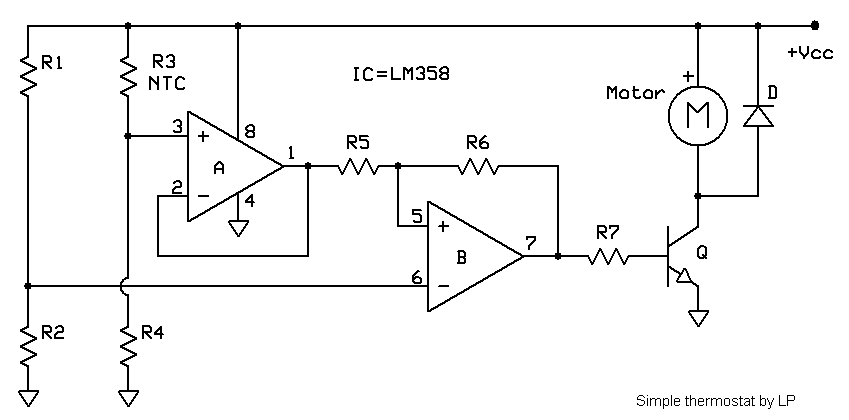This circuit is simillar to numerous other simple thermostats. The prime cause of presenting it here is to serve as a nice example of what is the main role of comparatos with hysteresis so that young readers can start using this valuable technique in their own designs.
Comparator with hysteresis
This little circuit can be used to reliably control loads in on/off fashion according to remote probe temperature. It is in essence a voltage comparator, although not the simple one but the one with the so called "hysteresis". This means that the comaprator doesn't change its output state if input voltage variations are smaller than the threshold, but only if they are of sufficient amplitude. "Comparator with hysteresis" function is implemented by connecting the comparator output and its noninverting input via a resistor, which is a standard way of doing this.

How this circuit works? To start with, the left half of the IC is simply a voltage follower which replicates voltage it observes at its noninverting input (PIN 3) to its output (PIN 1). The purpose of this amplifier is to isolate sensor (R3) and its biasing resistor (R4) from the rest of the circuit. So only the right half of the IC works as a comparator. DC voltage present at comparator noninverting input (PIN 5) can be taught of as reference voltage with which the comparator compares variable input voltage it observes at its inverting input (PIN 6). Let's assume that comparator input voltage is below the threshold so that its output voltage is high. If there was no R6 resistor in the circuit (which we will write as Rh in this article on), and if input voltage is only slightly below the threshold, then tiny positive variations in input voltage, caused by external or thermal noise etc, could force the comparator to invert its ouput state. Since comparator voltage amplification is very high, on the order of millions, input voltage variations as small as few ÁV can lead to frequent and unexpected inversions of comparator output state. This could not be considered reliable circuit operation.
So what do we do? If Rh resistor is present in the circuit, and if comparaor output voltage is high, then reference voltage at comparator positive input is a bit higher than it would be without Rh. We can write this as: Vref + = (Vref + Vh). This means that input voltage at comparator inverting output needs to be of sufficient amplitude in order to be able to cause output state inversion. On the other hand, if output voltage is low, Rh causes reference voltage to become lower than it would be without the Rh, so after once becoming higher than the positive Vref threshold, in order to once again cause output state inversion, input voltage at comparator inverting input will have to become lower than: Vref - = (Vref - Vh). To sum up, in order to cause alternating inversions of comparator output state, input voltage variations have to be larger than:
VTRIG = Vref + - Vref - = Vref + Vh - Vref + Vh = 2Vh .
Value Vh can roughly be calculated as supply voltage multiplied by the ratio between input resistanse that can be observed at the inverting comparator input, which in this circuit is simply R5, and Rh, which in this circuit is R6. Therefore, in this particular circuit: Vh = Vcc * (R5 / R6) .
Well... carefull readers have noticed that it was a bit strange to call sensor voltage "reference voltage" and to call constant DC voltage formed by voltage divider R1/R2 input voltage. Of course it is, but what is in fact important for understanding the circuit operation is that it compares one constant voltage with the other variable one. We intentionally swapped voltage designations in this article in order to explain general operation of the comparator with hysteresis circuit, while in some particular implementations, such as in this one, voltage roles might be reversed. We hope that young enthusiasts will understand this little trick and remember that it often pays off to think a bit out of the box.

